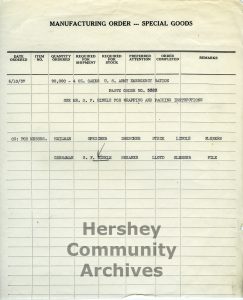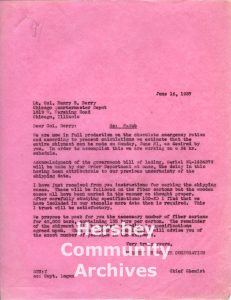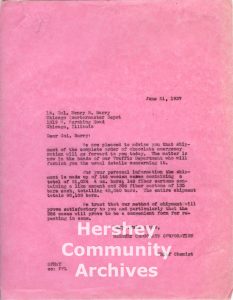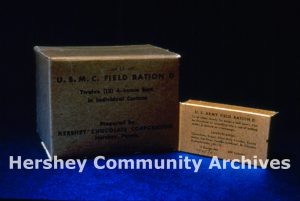HersheyArchives@30, Part 19: Serving the Nation – Hershey and the Ration D Bar
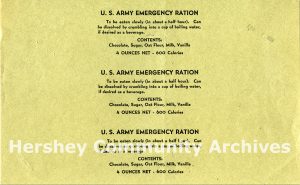
When the United States Army needed a food product that would serve as a survival ration for soldiers in combat situations, they turned to the Hershey Chocolate Corporation.
In the spring of 1937, Captain Paul Logan, from the office of U.S. Army Quartermaster General, met with William Murrie, President, Hershey Chocolate Corporation and Sam Hinkle, Chief Chemist. The Army wanted to develop an emergency ration bar.
Milton Hershey was very supportive of the request and instructed Sam Hinkle to get started right away.
While developing the formula for the survival ration bar was relatively simple, manufacturing the bars presented greater challenges.
Unlike Hershey’s confectionery products where warm chocolate pours easily into moulds, the non-confectionery chocolate paste for the Field Ration D bar, as it was formally known, was much thicker and did not flow at any temperature. A new method of moulding would need to be engineered.
For the first batch of Ration D bars, Hershey Chocolate Corporation planned to produce 90,000 bars for the U.S. Army Quartermaster Corps. First, the factory needed to construct enough moulds for the project. Next, the specially formulated Ration D chocolate paste was produced and each four-ounce portion was weighed, kneaded, and pressed into the mould by hand. It took the chocolate factory three weeks to produce the first run of 90,000 bars.
The challenges to deliver this product were not over yet.
The United States Army had detailed requirements for the wrapping and packaging of this product. From the bar wrapper to the boxes to the shipping cartons, Hershey had to follow very specific guidelines as to the information printed on the wrappers and cartons. As the letter notes, Hershey Chocolate provided 42,000 bars packed in wooden crates, specifically as the Army Quartermaster had specified, and 48,000 packed in fiberboard cartons. In spite of the Army’s specific instructions, Hinkle noted that the company would not pack the bars in rectangular tins since they did not have the necessary equipment.
Between 1937 and 1941, small contracts were awarded to Hershey for additional orders of the Ration D bar. As war became more imminent, and Hershey realized that production would need to increase, the factory developed an automated method of moulding.
In 1939, Hershey was able to produce 100,000 units per day. By the end of 1945, production lines on three floors of the plant were producing approximately 24 million units per week. It has been estimated that between 1940 and 1945, over three billion ration units were produced and distributed to military personnel around the world.
#HersheyArchives@30
